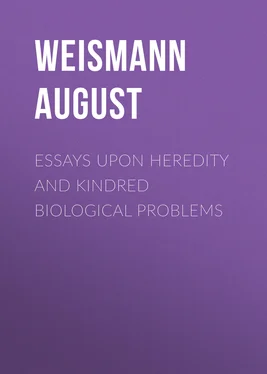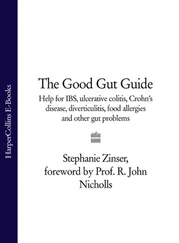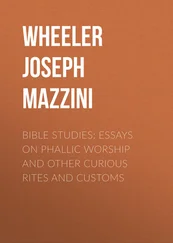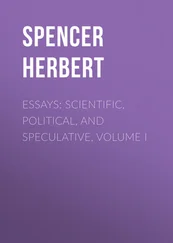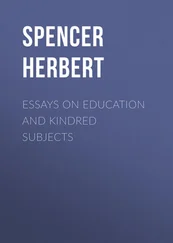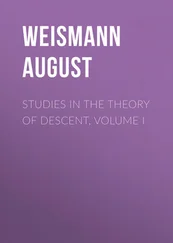August Weismann - Essays Upon Heredity and Kindred Biological Problems
Здесь есть возможность читать онлайн «August Weismann - Essays Upon Heredity and Kindred Biological Problems» — ознакомительный отрывок электронной книги совершенно бесплатно, а после прочтения отрывка купить полную версию. В некоторых случаях можно слушать аудио, скачать через торрент в формате fb2 и присутствует краткое содержание. Жанр: foreign_antique, Биология, на английском языке. Описание произведения, (предисловие) а так же отзывы посетителей доступны на портале библиотеки ЛибКат.
- Название:Essays Upon Heredity and Kindred Biological Problems
- Автор:
- Жанр:
- Год:неизвестен
- ISBN:нет данных
- Рейтинг книги:5 / 5. Голосов: 1
-
Избранное:Добавить в избранное
- Отзывы:
-
Ваша оценка:
- 100
- 1
- 2
- 3
- 4
- 5
Essays Upon Heredity and Kindred Biological Problems: краткое содержание, описание и аннотация
Предлагаем к чтению аннотацию, описание, краткое содержание или предисловие (зависит от того, что написал сам автор книги «Essays Upon Heredity and Kindred Biological Problems»). Если вы не нашли необходимую информацию о книге — напишите в комментариях, мы постараемся отыскать её.
Essays Upon Heredity and Kindred Biological Problems — читать онлайн ознакомительный отрывок
Ниже представлен текст книги, разбитый по страницам. Система сохранения места последней прочитанной страницы, позволяет с удобством читать онлайн бесплатно книгу «Essays Upon Heredity and Kindred Biological Problems», без необходимости каждый раз заново искать на чём Вы остановились. Поставьте закладку, и сможете в любой момент перейти на страницу, на которой закончили чтение.
Интервал:
Закладка:
But if the essential nature of the germ-cell dominates over the organism which will grow from it, so also the quantitative individual differences, to which I referred just now, are, by the same principle, established in the germ, and—whatever be the cause which determines their presence—they must be looked upon as inherent in it. It therefore follows that, although natural selection appears to operate upon the qualities of the developed organism alone, it in truth works upon peculiarities which lie hidden in the germ-cells. Just as the final development of any predisposition in the germ, and just as any character in the mature organism vibrates with a certain amplitude around a fixed central point, so the predisposition of the germ itself fluctuates, and it is on this that the possibility of an increase of the predisposition in question, and its average result, depends.
If we trace all the permanent hereditary variations from generation to generation back to the quantitative variations of the germ, as I have sought to do, the question naturally occurs as to the source from which these variations arose in the germ itself. I will not enter into this subject at any length on the present occasion, for I have already expressed my opinion upon it 58.
I believe however that they can be referred to the various external influences to which the germ is exposed before the commencement of embryonic development. Hence we may fairly attribute to the adult organism influences which determine the phyletic development of its descendants. For the germ-cells are contained in the organism, and the external influences which affect them are intimately connected with the state of the organism in which they lie hid. If it be well nourished, the germ-cells will have abundant nutriment; and, conversely, if it be weak and sickly, the germ-cells will be arrested in their growth. It is even possible that the effects of these influences may be more specialized; that is to say, they may act only upon certain parts of the germ-cells. But this is indeed very different from believing that the changes of the organism which result from external stimuli can be transmitted to the germ-cells and will re-develope in the next generation at the same time as that at which they arose in the parent, and in the same part of the organism.
We have an obvious means by which the inheritance of all transmitted peculiarities takes place, in the continuity of the substance of the germ-cells, or germ-plasm . If, as I believe, the substance of the germ-cells, the germ-plasm, has remained in perpetual continuity from the first origin of life, and if the germ-plasm and the substance of the body, the somatoplasm, have always occupied different spheres, and if changes in the latter only arise when they have been preceded by corresponding changes in the former, then we can, up to a certain point, understand the principle of heredity; or, at any rate, we can conceive that the human mind may at some time be capable of understanding it. We may at least maintain that it has been rendered intelligible, for we can thus trace heredity back to growth; we can thus look upon reproduction as an overgrowth of the individual, and can thus distinguish between a succession of species and a succession of individuals, because in the latter succession the germ-plasm remains similar, while in the succession of the former it becomes different. Thus individuals, as they arise, are always assuming new and more complex forms, until the interval between the simple unicellular protozoon and the most complex of all organisms—man himself—is bridged over.
I have not been able to throw light upon all sides of the question which we are here discussing. There are still some essential points which I must leave for the present; and, furthermore, I am not yet in a position to explain satisfactorily all the details which arise at every step of the argument. But it appeared to me to be necessary to state this weighty and fundamental question, and to formulate it concisely and definitely; for only in this way will it be possible to arrive at a true and lasting solution of the problem. We must however be clear on this point—that the understanding of the phenomena of heredity is only possible on the fundamental supposition of the continuity of the germ-plasm. The value of experiment in relation to this question is somewhat doubtful. A careful collection and arrangement of facts is far more likely to decide whether, and to what extent, the continuity of germ-plasm is reconcilable with the assumption of the transmission of acquired characters from the parent body to the germ, and from the germ to the body of the offspring. At present such transmission is neither proved as a fact, nor has its assumption been shown to be unquestionably necessary.
III.
LIFE AND DEATH.
1883
LIFE AND DEATH.
PREFACE
The following paper was first printed as an academic lecture in the summer of the present year (1883), with the title ‘Upon the Eternal Duration of Life’ (‘Über die Ewigkeit des Lebens’). In now bringing it before a larger public in an expanded and improved form, I have chosen a title which seemed to me to correspond better with the present contents of the paper.
The stimulus which led to this biological investigation was given in a memoir by Götte, in which this author opposes views which I had previously expressed. Although such an origin has naturally caused my paper to take the form of a reply, my intention was not merely to controvert the views of my opponent, but rather—using those opposed views as a starting-point—to throw new light upon certain questions which demand consideration; to give additional support to thoughts which I have previously expressed, and to penetrate, if possible, more deeply into the problem of life and death.
If, in making this attempt, the views of my opponent have been severely criticized, it will be acknowledged that the criticisms do not form the purpose of my paper, but only the means by which the way to a more correct understanding of the problems before us may be indicated.
A. W.Freiburg i. Breisgau,
Oct. 18, 1883 .
III.
LIFE AND DEATH
In the previous essay, entitled ‘The Duration of Life,’ I have endeavoured to show that the limitation of life in single individuals by death is not, as has been hitherto assumed, an inevitable phenomenon, essential to the very nature of life itself; but that it is an adaptation which first appeared when, in consequence of a certain complexity of structure, an unending life became disadvantageous to the species. I pointed out that we could not speak of natural death among unicellular animals, for their growth has no termination which is comparable with death. The origin of new individuals is not connected with the death of the old; but increase by division takes place in such a way that the two parts into which an organism separates are exactly equivalent one to another, and neither of them is older or younger than the other. In this way countless numbers of individuals arise, each of which is as old as the species itself, while each possesses the capability of living on indefinitely, by means of division.
I suggested that the Metazoa have lost this power of unending life by being constructed of numerous cells, and by the consequent division of labour which became established between the various cells of the body. Here also reproduction takes place by means of cell-division, but every cell does not possess the power of reproducing the whole organism. The cells of the organism are differentiated into two essentially different groups, the reproductive cells—ova or spermatozoa, and the somatic cells, or cells of the body, in the narrower sense. The immortality of the unicellular organism has only passed over to the former; the others must die, and since the body of the individual is chiefly composed of them, it must die also.
Читать дальшеИнтервал:
Закладка:
Похожие книги на «Essays Upon Heredity and Kindred Biological Problems»
Представляем Вашему вниманию похожие книги на «Essays Upon Heredity and Kindred Biological Problems» списком для выбора. Мы отобрали схожую по названию и смыслу литературу в надежде предоставить читателям больше вариантов отыскать новые, интересные, ещё непрочитанные произведения.
Обсуждение, отзывы о книге «Essays Upon Heredity and Kindred Biological Problems» и просто собственные мнения читателей. Оставьте ваши комментарии, напишите, что Вы думаете о произведении, его смысле или главных героях. Укажите что конкретно понравилось, а что нет, и почему Вы так считаете.
